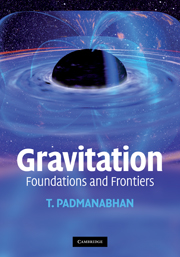Book contents
- Frontmatter
- Contents
- List of exercises
- List of projects
- Preface
- How to use this book
- 1 Special relativity
- 2 Scalar and electromagnetic fields in special relativity
- 3 Gravity and spacetime geometry: the inescapable connection
- 4 Metric tensor, geodesics and covariant derivative
- 5 Curvature of spacetime
- 6 Einstein's field equations and gravitational dynamics
- 7 Spherically symmetric geometry
- 8 Black holes
- 9 Gravitational waves
- 10 Relativistic cosmology
- 11 Differential forms and exterior calculus
- 12 Hamiltonian structure of general relativity
- 13 Evolution of cosmological perturbations
- 14 Quantum field theory in curved spacetime
- 15 Gravity in higher and lower dimensions
- 16 Gravity as an emergent phenomenon
- Notes
- Index
13 - Evolution of cosmological perturbations
Published online by Cambridge University Press: 05 June 2012
- Frontmatter
- Contents
- List of exercises
- List of projects
- Preface
- How to use this book
- 1 Special relativity
- 2 Scalar and electromagnetic fields in special relativity
- 3 Gravity and spacetime geometry: the inescapable connection
- 4 Metric tensor, geodesics and covariant derivative
- 5 Curvature of spacetime
- 6 Einstein's field equations and gravitational dynamics
- 7 Spherically symmetric geometry
- 8 Black holes
- 9 Gravitational waves
- 10 Relativistic cosmology
- 11 Differential forms and exterior calculus
- 12 Hamiltonian structure of general relativity
- 13 Evolution of cosmological perturbations
- 14 Quantum field theory in curved spacetime
- 15 Gravity in higher and lower dimensions
- 16 Gravity as an emergent phenomenon
- Notes
- Index
Summary
Introduction
The evolution of the homogeneous universe was described in Chapter 10. Following up on that, we shall now turn to the study of the formation of structures in the universe. The key idea is that if there were small fluctuations in the energy density in the early universe, then the gravitational instability could amplify them leading – eventually – to structures like galaxies, clusters, etc. The most popular model for generating the initial fluctuations is based on the paradigm that, if the very early universe went through a phase of accelerated expansion (called the inflationary phase), then the quantum fluctuations of the field driving the inflation could lead to fluctuations in the energy density. (We will discuss this idea in detail in Chapter 14.) When the perturbations are small, one can use the linear perturbation theory to study its growth. The observations of cosmic microwave background radiation (CMBR) at z ≃ 103 show that the fractional perturbations in the energy density were quite small (about 10−4–10−5) at z ≈ 1000 when the matter and radiation decoupled. Hence, linear perturbation theory can be used to make clear predictions about the state of the universe at z ≈ 1000 and to study the anisotropies in the CMBR. This will be one key application of the formalism developed in this chapter.
Structure formation and linear perturbation theory
The basic idea behind linear perturbation theory in cosmology is well defined and simple.
- Type
- Chapter
- Information
- GravitationFoundations and Frontiers, pp. 560 - 590Publisher: Cambridge University PressPrint publication year: 2010



